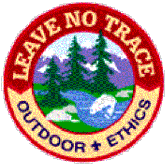
The Leave-No-Trace principle has been adopted by Scouting for activities held in other than established campgrounds. This page outlines the Leave-No-Trace principles. For more information visit the official Leave-No-Trace site, or pick up the excellent book Leave No Trace by Annette McGivney at a bookstore, or your local Boy Scout Shop.
Principles to Live by
When teaching LNT skills and ethics, NOLS stresses that the six basic principles around which the minimum-impact ethic has been built are not hard-and-fast rules, but guidelines aimed at helping backcountry users make ecologically sound decisions in various environments and situations. These guidelines are the foundation of what has become a new wilderness etiquette, an ethic toward recreating in the backcountry that is eons from the days when it was common practice to turn campsites into garbage dumps. Throughout this book, the principles of Leave No Trace are expanded upon, but here is the encapsulated version of six guidelines to live by when visiting the great outdoors:
1. Plan Ahead and Prepare
- Call ahead to the place you intend to visit to find out about any special environmental concerns, regulations, or permits.
- Be prepared for harsh conditions by bringing proper equipment and knowing how to use it.
- Carefully plan meals so that there is no food waste. Reduce your amount of trash by repackaging food in reusable containers.
- Invest in modern gear that aids in environmentally responsible camping. Use a lightweight stove to replace the need for cooking over fires; get a tent with a watertight floor; become the proud owner of a trowel to aid in the digging of cat holes.
- Try to stay away from popular areas during times of high use, such as holidays and weekends. If you are in a group of four or more, take special care to avoid popular areas during busy times.
2. Camp and Travel on Durable Surfaces
- Help mitigate trampling and erosion problems by staying on designated trails; walk in single file in the middle of the path.
- When traveling cross-country where there are no trails, try to stay on the most durable surfaces – rock, gravel, dry grasses, or snow.
- In areas frequented by visitors, camp at a designated site that shows obvious signs of use – soil is compacted, vegetation is sparse. and keep your activities concentrated in the impacted area.
- If you are lucky enough to be in a pristine area that shows few signs of human visitation, disperse your individual impact by camping in a never-before-used site. Stay away from campsites that have already been lightly: impacted.
3. Pack It In; Pack It Out
- Do not be a slob – be careful not to disrupt wildlife bv leaving food scraps around camp.
- Keep your gear organized in camp so that you do not accidentally leave something behind.
- Burying trash is not a good idea, because wildlife will just dig it up, and burning it is not environmentally sound either.
4. Properly Dispose of What You Cannot Pack Out
- You can pack out your poop if you really want to, but it is perfectly acceptable in most wilderness areas to bury it in a cat hole that is 4 to 8 inches deep and at least 200 feet from water, camp, or trails.
- Scrutinize your need for toilet paper; nature provides a variety of environmentally friendly tissue alternatives. if you must use toilet paper, pack it out.
- Keep pollutants out of water sources by camping at least 200 feet from lakes and streams.
- To wash yourself or your dishes, carry water 2 00 feet from streams or lakes, and use small amounts of biodegradable soap. Strain dishwater with a cloth and then scatter the water or sump.
5. Leave What You Find
- For starters, it is against federal law to disturb archaeological or historic sites. no not disturb these relics of our nation’s heritage, and camp well away from such sites.
- Observe wildlife from a distance and do not feed the animals.
- Avoid altering a campsite – such as driving a nail in a tree or making a ‘ bench out of a log – to accommodate your desires for comfort. If you move a log or rock to improve a sleeping area, replace it when leaving camp.
- Take home memories instead of souvenirs such as interesting rocks or wildflowers.
6. Minimize Use and Impact of Fires
- Although a cozy and longtime tradition, campfires can cause permanent scars to an area; use a stove instead.
- If you must have a fire, use an existing fire ring or build a no-trace mound or pan fire.
- For fuel, gather sticks from the ground that are no larger in diameter than an adult’s wrist. Do not pull branches off dead or downed trees.
- When vacating the site, put out your fire completely, pack out all unburned trash from the fire ring., and scatter the cool ashes over a large area well away from camp.